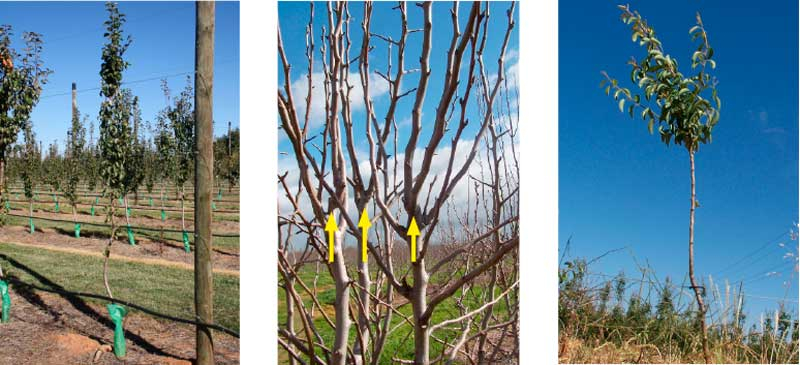Several articles in this journal by this author have shown that high density pear trees on seedling rootstock, or on their own roots (as softwood cuttings), can match early and high yields of high density apple trees on size-controlling rootstocks—but only when pear trees are tamed early and it is recognised that the growth habit of the pear is different from that of the apple.
The major problem with pear trees is their strong apical dominance, which limits their willingness to form lateral shoots. Their natural growth habit is upright with few branches (see Photo 1). Pruning, using heading cuts to force breaks (shoots), often exacerbates the problem with more vigorous upright shoots near the cut (see Photo 2). We also know that pruning young trees delays cropping.
The belief that only an equivalent M9 rootstock for pear trees can match early apple yields, is outdated. There are more pear rootstocks in the world than apple rootstocks—none of them come near the efficiency and productivity of M9 or M26.
That’s why we need to look beyond the rootstock ‘waiting-and-pretending game’, and start thinking ‘outside the box’, and use proven tree training methods, with the help of chemical and mechanical methods, to tame pear trees.
This article deals with the early development of the tree’s structure. However, it must be remembered, that pear trees planted as bare-rooted trees from a nursery can suffer from transplant shock (not to be confused with replant disease). In this article it is assumed that measures have been taken to prevent transplant shock.
What is apical dominance?
The pattern of growth and branching is largely determined by the phenomenon of apical dominance in which the apical buds of shoots dominate growth and control the development of lateral buds lower down the shoot. (see Photo 3).
The plant hormone auxin is produced in quantity by the earliest young leaves, stimulating the development of better vascular connections and thus developing preferential accumulation of nutrients, growth regulators, and carbohydrates.
In this way the apex of a leader becomes dominant.
The auxin produced by the young leaves moves down the shoot by gravity and inhibits the development of lateral buds.
The intensity of apical dominance varies between species and variety, typically being very strong in pear and cherry, while peach is notably less apically controlled.
The degree of apical control therefore regulates the rate of terminal shoot growth, the distribution of lateral shoots, the length and the branch angles of these laterals.
So, when you manage apical dominance in young closely-planted pear tree, you are well on the way of taming it, and turning the high density orchard into a fruit-producing machine instead of a wood-producing machine.
Tree structure
The framework, or structure of a fruit tree consists of different parts of different ages. (continued next issue)
See this article in Tree Fruit May 2021






















